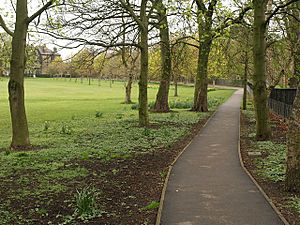The Stray (Harrogate) facts for kids
The Stray is a huge public park in the middle of Harrogate, North Yorkshire, England. It covers about 200 acres of open land. This land connects the town's famous healing springs and wells. The Stray forms a U-shape around parts of Harrogate. It stretches from the Cenotaph to The Granby. It also includes Tewit Well, marked by a special dome.
Contents
The History of The Stray
From Royal Forest to Public Park
Long ago, the area of The Stray was part of the Forest of Knaresborough. This was a special royal hunting forest. In 1369, it became owned by John of Gaunt, a powerful duke. The land stayed with the Duchy of Lancaster, which still owns The Stray today.
By the 1700s, Harrogate was growing as a spa town. People came for its healing waters. The Duchy of Lancaster worried about people building on their land without permission. They thought about dividing up the forest.
In 1767, a survey was done. This led to a law in 1770 called the Act of Enclosure. But the people who managed this law saw how important the open land was. It let visitors easily reach the many mineral springs.
The Great Award and Grazing Rights
So, in 1778, they made a special decision called the Great Award. This award set aside 200 acres of land. It said this land must always stay open. It also made sure people could always walk and exercise there. This was perfect for those seeking the "cure" from the springs.
The Award also gave people "grazing rights" on this open land. This meant animals could roam freely without being tied up. This is how the land got its popular name, The Stray. The word "stray" is used in other parts of Yorkshire for open, unenclosed land.
Managing The Stray Over Time
At first, there were no rules for managing The Stray. In 1841, a new law, the Harrogate Improvement Act, created a committee. This committee was made of people who owned grazing rights. But this often meant they rented out parts of The Stray for other uses.
In 1884, Harrogate became a proper town with its own council. The new council bought the grazing rights. Then, in 1893, another law was passed. This law made the council responsible for keeping The Stray as a public open space forever.
Protecting The Stray Today
In 1932, the council planted many formal gardens on The Stray. Some people didn't like this. So, in 1933, they formed the Stray Defence Association. This group worked to protect The Stray.
A more recent law, the Harrogate Stray Act 1985, made the new Harrogate Borough Council the official protector of The Stray. This law also allowed up to 8.5 acres of The Stray to be used for big events. For example, a special permission was given for the 2014 Tour de France cycling race. However, plans in 2016 to allow more events permanently were stopped because of public opposition.
The Stray has always been a place for parades and town events. For instance, in 1887, for Queen Victoria's Golden Jubilee, the people of Harrogate roasted an ox and drank huge amounts of beer! During World War II, trenches were dug on The Stray. This was done because people feared German planes might try to land on the open ground.


